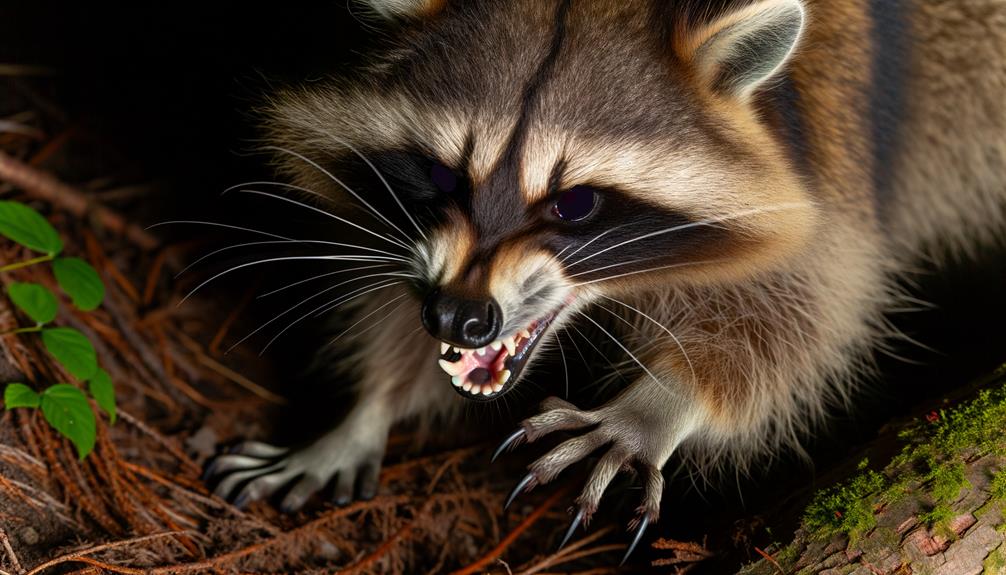3 Key Differences in Male and Female Raccoons Being More Aggressive
Male raccoons exhibit higher aggression levels, especially during the breeding season and territorial disputes. They often engage in physical confrontations, scent marking, and vocalizations to establish dominance and protect their home ranges.
Female raccoons, while generally less aggressive, show heightened aggression during offspring rearing, particularly in the first eight weeks postpartum. This maternal defense includes growling, biting, and chasing potential threats.
Aggression in male raccoons peaks in spring and summer, while maternal aggression in females increases near nesting sites. These behavioral differences notably affect human-raccoon interactions, particularly in urban environments.
Learn more about the complexities of raccoon behavior and human-wildlife interactions.

Key Takeaways
- Male raccoons exhibit higher aggression during mating season and territorial disputes.
- Female raccoons show heightened aggression when protecting offspring, especially during the first eight weeks postpartum.
- Male raccoons are more assertive in defending food sources and larger home ranges.
- Female raccoons' aggression increases near nesting sites and during food competition.
- Urban raccoons, especially males, display higher aggression levels compared to rural ones.
Raccoon Behavioral Basics

Raccoons (Procyon lotor) exhibit a range of behaviors that are important for their survival, including foraging, mating, and social interactions.
These nocturnal animals use tactile dexterity to forage, often manipulating objects to access food. Studies indicate that raccoons possess a highly developed sense of touch, with over 70% of their cerebral cortex dedicated to processing tactile information.
During mating seasons, typically in late winter, males and females engage in vocalizations and scent marking to communicate reproductive readiness.
Socially, raccoons exhibit both solitary and communal behaviors, with females often sharing dens during the harsh winter months.
Understanding these behavioral basics is essential for thoroughly examining the distinctions in aggression levels between male and female raccoons.
Aggression in Wildlife
While aggression is a common trait across various wildlife species, its manifestations and triggers can differ considerably depending on ecological and social factors. Studies show that aggression can be influenced by resource competition, territorial disputes, and mating behaviors. Variations in aggressive behavior are often observed among species, and even within the same species under different environmental conditions. The table below highlights key factors influencing aggression in wildlife:
| Factor | Description | Example Species |
|---|---|---|
| Resource Scarcity | Limited food/water increases conflict | Lions |
| Territoriality | Defense of habitat from intruders | Wolves |
| Mating Competition | Rivalry for mates | Deer |
| Parental Defense | Protecting offspring | Bears |
| Social Hierarchies | Establishing dominance | Primates |
Understanding these factors can aid in predicting and managing wildlife aggression.
Male Raccoon Behavior

Male raccoons exhibit a range of behaviors that are greatly influenced by their need to secure resources, establish territory, and compete for mating opportunities. Studies indicate that male raccoons display heightened levels of aggression during the breeding season, primarily driven by competition for access to females. This aggression often manifests in physical confrontations with other males.
Additionally, territorial behavior is marked by scent marking and vocalizations to ward off potential rivals. Males also demonstrate resource-guarding behaviors, particularly in areas abundant with food. Data from field observations and telemetry studies reveal that male raccoons have larger home ranges compared to females, an adaptation likely linked to their competitive and resource-driven nature.
Such behaviors underscore the complexity of male raccoon social dynamics.
Female Raccoon Behavior
Female raccoons exhibit distinct behavioral patterns primarily driven by maternal protective instincts, including heightened aggression during the rearing of offspring. Their denning and territory defense behaviors are essential for ensuring the safety and survival of their young, often leading to increased territorial aggression.
Additionally, female raccoons navigate complex social hierarchy dynamics, which can influence their interactions and levels of aggression within raccoon populations.
Maternal Protective Instincts
Maternal protective instincts in female raccoons are particularly heightened during the rearing of their young, driven by the necessity to safeguard offspring from potential threats. Data indicate that this heightened aggression is most pronounced during the first eight weeks postpartum, when juveniles are most vulnerable. Female raccoons exhibit increased vigilance and are more likely to engage in defensive behaviors, such as growling, biting, and chasing away potential predators, including other raccoons.
Research has documented a significant rise in confrontational encounters during this period, suggesting a direct correlation between maternal status and aggressive behavior. These protective behaviors are essential for the survival of the offspring, underscoring the adaptive significance of maternal aggression in female raccoons.
Denning and Territory Defense
In the context of denning and territory defense, female raccoons exhibit a marked increase in territorial aggression to secure and protect their nesting sites. Studies indicate that female raccoons establish defined territories, particularly during the breeding season, to safeguard their dens and offspring.
Data show that females engage in aggressive behaviors such as growling, biting, and physical confrontations to ward off intruders. This heightened aggression is linked to the necessity of ensuring the safety of their young, reducing the risk of predation and competition for resources.
Observations reveal that female raccoons are more likely to confront not only other raccoons but also potential threats from different species, underscoring their commitment to den security.
Social Hierarchy Dynamics
Social hierarchy dynamics among female raccoons are characterized by a complex structure wherein dominant individuals assert control over prime resources and den sites. Data indicate that dominant females often gain access to superior food sources and more secure nesting areas, which directly impacts their reproductive success.
Intraspecific interactions among female raccoons reveal that aggression is often employed to establish and maintain hierarchical status. Observational studies have documented instances of physical confrontations and vocalizations used to deter subordinates. Importantly, the presence of kinship bonds can modulate these aggressive behaviors, as related females tend to form cooperative groups.
Understanding these dynamics is essential for comprehending how resource competition and social structures influence female raccoon behavior and overall population health.
Territorial Instincts

Territorial instincts in raccoons manifest through behaviors aimed at defending nesting areas and competing for limited resources.
Males are often observed exhibiting higher levels of aggression when securing territories, particularly during mating season.
Conversely, female raccoons primarily demonstrate defensive aggression to protect their young and nesting sites from potential threats.
Defending Nesting Areas
Male and female raccoons exhibit distinct behaviors when defending nesting areas. Males typically show higher levels of aggression due to their larger territories and greater competition for resources. Research indicates that male raccoons often engage in more frequent and intense confrontations to secure and maintain their nesting sites.
Female raccoons, while also protective of their nesting areas, especially when offspring are present, tend to adopt less confrontational strategies.
Key distinctions in behavior include:
- Territorial Range: Males have larger territories, leading to more frequent territorial disputes.
- Aggression Levels: Males exhibit higher aggression to defend their expansive territories.
- Protective Behavior: Females are highly protective of their young but engage in fewer territorial conflicts.
These behavioral patterns underscore the differing strategies employed by both sexes in nesting area defense.
Competing for Resources
Raccoons demonstrate varying aggression levels when competing for resources, with males generally displaying more assertive territorial instincts compared to females. Research indicates that male raccoons exhibit higher levels of aggression when defending food sources, often engaging in physical confrontations to establish dominance. This behavior is particularly pronounced during mating seasons when resource competition intensifies.
Conversely, female raccoons, while protective of their young and immediate food supplies, typically display less aggressive behaviors in broader territorial disputes. Studies have also shown that males have larger home ranges, necessitating more aggressive encounters to secure adequate resources. These findings underscore the role of gender-specific territorial behaviors in shaping raccoon aggression patterns, providing valuable insights into their ecological interactions and survival strategies.
Mating Season Dynamics
During the mating season, notable differences in aggression levels between male and female raccoons become particularly evident. Male raccoons exhibit heightened aggression primarily due to competition for access to receptive females. This behavioral change is driven by the need to secure mating opportunities and can result in intense confrontations.
Conversely, female raccoons display increased aggression mainly to protect themselves from overly persistent males and to assert dominance over potential rivals.
Key observations during the mating season include:
- Male-to-Male Aggression: To establish mating rights and deter competitors.
- Female Resistance: Females often fend off unwanted advances by aggressive suitors.
- Hierarchy Establishment: Both genders display increased aggression to establish social hierarchies, influencing mating success.
These dynamics underline the significance of aggression in raccoon reproductive behavior.
Parental Protection

Parental protection behaviors in raccoons exhibit significant sex-based differences. Females primarily engage in maternal defense mechanisms, showing heightened aggression when defending their offspring. They employ physical deterrence and vocalizations to protect their young from potential threats.
On the other hand, males focus on territorial guarding. They display increased territorial aggression to secure resources and safe spaces for their progeny. Data indicate that these sex-specific behaviors play crucial roles in the survival and well-being of raccoon families.
Maternal Defense Mechanisms
When threatened, female raccoons exhibit heightened aggression as a critical component of their maternal defense mechanisms to protect their offspring. This behavior is driven by several biological and environmental factors:
- Proximity to Offspring: Female raccoons are more likely to display aggression when potential threats are near their young.
- Hormonal Influences: Elevated levels of oxytocin and prolactin during the nursing period enhance protective instincts and aggressive behaviors.
- Risk Assessment: Female raccoons assess the threat level and respond with appropriate aggression to deter predators effectively.
Studies indicate that this maternal aggression is essential for the survival of offspring, as it reduces predation risks. Female raccoons' defensive behaviors are hence a pivotal aspect of their reproductive strategy, ensuring higher survival rates for their young.
Paternal Territory Guarding
Male raccoons demonstrate territorial aggression primarily as a means of safeguarding their mating opportunities and ensuring the protection of their territory from rival males. This behavior is vital in maintaining access to resources and potential mates. Studies indicate that male raccoons engage in more frequent and intense territorial disputes compared to females. The following table presents data on territorial aggression in male raccoons.
| Behavior | Frequency | Intensity |
|---|---|---|
| Territorial Marking | High | Moderate |
| Physical Confrontation | Moderate | High |
| Vocalization | High | Low |
| Patrol and Surveillance | High | Moderate |
Understanding these behaviors is important for comprehending the broader implications of raccoon aggression. By protecting their domain, male raccoons optimize their reproductive success and resource acquisition.
Food Competition
In food competition scenarios, female raccoons have been observed to exhibit higher levels of aggression compared to their male counterparts, likely due to their greater need to secure resources for offspring. This behavior is supported by several studies that highlight the following points:
- Maternal Investment: Female raccoons must provide for their young, necessitating more assertive tactics to secure sufficient food.
- Resource Scarcity: In periods of food scarcity, females demonstrate increased assertiveness to guarantee the survival of their offspring.
- Territorial Defense: Females are more likely to defend prime foraging locations assertively to maximize resource availability for their young.
These factors collectively underscore the heightened aggression observed in female raccoons during food competition, driven by their reproductive and nurturing responsibilities.
Seasonal Behavior Changes

Seasonal behavior changes in raccoons exhibit significant variations in aggression levels, influenced by factors such as mating cycles, food availability, and environmental conditions.
During the mating season, typically occurring between late winter and early spring, male raccoons display heightened aggression as they compete for access to females. Conversely, females show increased defensive aggression to protect their young during the birthing and rearing periods in late spring and early summer.
In autumn, raccoons of both sexes may exhibit elevated aggression due to the necessity of fat accumulation for winter. Additionally, harsh environmental conditions, such as extreme cold or drought, can exacerbate competition for limited resources, further influencing aggressive behaviors.
Understanding these seasonal patterns is essential for managing raccoon populations and mitigating human-wildlife conflicts.
Study on Raccoon Aggression
Recent research on raccoon aggression has provided valuable insights by analyzing behavioral data collected across different seasons and geographical locations. The study focused on various factors to determine the aggression levels in male and female raccoons.
Key findings include:
- Seasonal Variations: Data indicated that aggression peaks during mating season, with males exhibiting more frequent aggressive behaviors.
- Geographical Differences: Urban raccoons displayed higher aggression levels compared to their rural counterparts, possibly due to competition for limited resources.
- Social Dynamics: Female raccoons exhibited increased aggression when protecting their offspring, suggesting maternal instincts strongly influence their behavior.
These findings underscore the complexity of raccoon aggression, driven by a mix of environmental and biological factors. Further research is essential to fully understand these dynamics.
Expert Observations

Several wildlife biologists and ethologists have provided detailed observations, revealing nuanced differences in aggression patterns between male and female raccoons. Males typically exhibit higher levels of aggression, particularly during mating seasons when competition for females intensifies. Data indicate increased instances of male-to-male confrontations, often resulting in physical altercations.
Conversely, female raccoons display heightened aggression primarily when defending their young. Ethological studies highlight that maternal aggression is a protective mechanism, ensuring offspring survival. Behavioral assessments further show that female raccoons, although generally less aggressive, can become highly combative when their perceived threats escalate.
These expert observations underscore the context-dependent nature of aggression in raccoons, influenced significantly by gender-specific roles and environmental pressures.
Human Interactions
Human interactions with raccoons reveal significant behavioral variations influenced by the raccoons' gender-specific aggression patterns.
Studies indicate that male raccoons exhibit higher levels of aggression, particularly during mating season and territorial disputes. Conversely, female raccoons are generally less aggressive but can display heightened aggression when protecting their young.
These behavioral traits impact human-raccoon encounters in several ways:
- Urban Encounters: Male raccoons are more likely to confront humans, especially when scavenging for food.
- Nesting Areas: Female raccoons' aggression increases near nesting sites, posing risks during human attempts to remove them.
- Seasonal Variations: Male aggression peaks in spring and summer, correlating with increased human-wildlife conflicts.
These insights underscore the importance of gender-specific strategies in managing raccoon interactions.
Conclusion
To sum up, the examination of raccoon aggression reveals that both male and female raccoons exhibit aggressive behaviors, though the triggers and contexts differ. Males display heightened aggression primarily due to territorial and mating instincts, while females become aggressive mainly when protecting offspring.
Skeptics may argue that aggression is uniformly distributed across genders; however, empirical studies and expert observations consistently highlight distinct behavioral patterns influenced by seasonal and reproductive factors, affirming the nuanced understanding of raccoon aggression.






